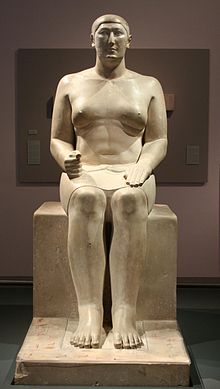Hemiunu
| Hemiunu | |||||
|---|---|---|---|---|---|
| Hereditary Prince King's son of his body | |||||
 Statue of Hemiunu at thePelizaeus Museum,Hildesheim,Germany,his feet rest on columns of hieroglyphs painted in yellow, red, brown, and black | |||||
| Egyptianname | |||||
| Dynasty | Fourth Dynasty of Egypt | ||||
| Father | Nefermaat | ||||
| Mother | Itet | ||||
Hemiunu(fl.2570 BC) was anancient Egyptianprince who is believed to have been thearchitectof theGreat Pyramid of Giza.[1][2]Asvizier,succeeding his father,Nefermaat,and his uncle,Kanefer,[3]Hemiunu was one of the most important members of the court and responsible for all the royal works. His tomb lies close to Khufu's pyramid.
Biography
[edit]Hemiunu was a son of princeNefermaatand his wife,Itet.[4]He is a grandson ofSneferuand a nephew ofKhufu,theOld Kingdompharaoh.Hemiunu had three sisters and many brothers.
In his tomb, he is described as a hereditary prince, count, sealer of the king of Lower Egypt (jrj-pat HAtj-a xtmw-bjtj), and on a statue found in hisserdab(and now located inHildesheim), Hemiunu is given the titles: king's son of his body, chief justice, and vizier, greatest of the five of the House of Thoth (sA nswt n XT=f tAjtj sAb TAtj wr djw pr-DHwtj).[5]
Tomb
[edit]Hemiunu's tomb lies close to Khufu's pyramid and containsreliefsof his image. Some stones of his badly damagedmastaba(G4000) are marked with dates referring to Khufu's reign.[6]His statue[7]can be found at thePelizaeus Museum,Hildesheim,Germany.[4]
His statue was found in the walled-upserdabof Hemiunu's mastaba by archaeologistHermann Junkerin March 1912. Ancient looters had ransacked the mastaba in their quest for valuable items and the wall to the serdab had a child-sized hole cut into it. The robber forcefully gouged out the statue's precious inlaid eyes and gold castings, in the process the right arm was broken and the head severed. The head has been restored,[8]using arelief of Hemiunuas a guide for the nose's profile.
The seated statue is well-preserved, apart from the damage mentioned above (importantly, his head being severed), and is notable for its realism, not found in ancient Egyptian art depicting royal figures. Hemiunu's features are only lightly stylized and clearly based on his appearance. He is depicted as obese, with notable accumulation of fat in the pectoral region. This contrasts with the more idealized representation of male subjects in royal portraiture in this and most succeeding periods ofancient Egyptian art.
Notes
[edit]- ^De Camp, p. 35
- ^Shaw, p. 89
- ^Cambridge, p. 166
- ^abArnold, p. 107
- ^"Archived copy".Archived fromthe originalon 2008-10-11.Retrieved2010-09-11.
{{cite web}}:CS1 maint: archived copy as title (link)page about G 4000, the tomb of Hemiunu - ^Strudwick, p. 157
- ^Tiradritti, p. 13
- ^N.Y.), Metropolitan Museum of Art (New York (1999).Egyptian Art in the Age of the Pyramids.Metropolitan Museum of Art.ISBN9780870999079.
References
[edit]- Dieter Arnold,The Encyclopaedia of Ancient Egyptian Architecture,I.B.Tauris, 2002
- Nigel C. Strudwick,Texts from the Pyramid,SBL, 2005
- Cambridge Ancient Historyby Cambridge University Press, 2000
- Francesco Tiradritti,Arte egizia,Giunti, 2002
- Lyon Sprague De Camp,Catherine Crook De Camp,Ancient Ruins and Archaeology,Doubleday, 1964
- Ian Shaw,The Oxford History of Ancient Egypt,Oxford University Press, 2003
See also
[edit] Media related toHemiunuat Wikimedia Commons
Media related toHemiunuat Wikimedia Commons
